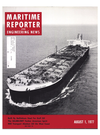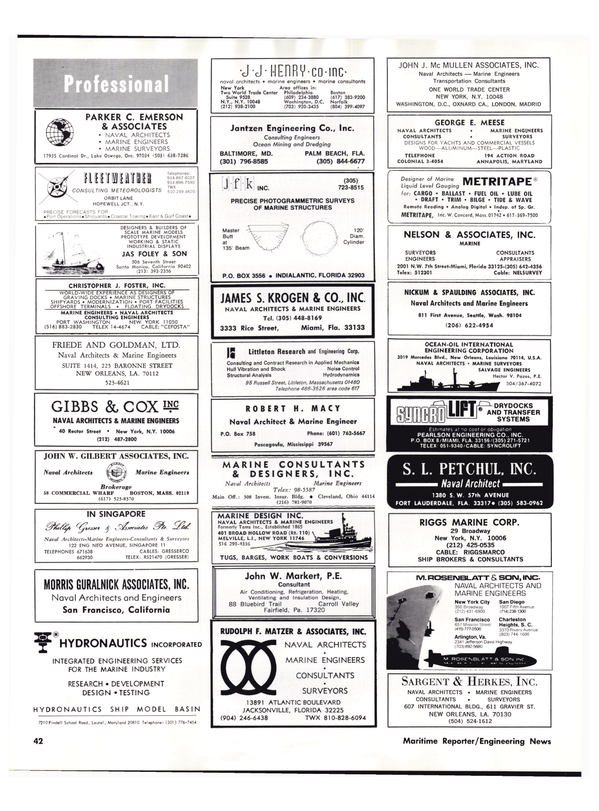
Modern Collision Avoidance System Subject Of Symposium
A ship can complete its voyage more safely and with fewer maneuvers if it is equipped with a modern collision avoidance system, according to experimenters at the U.S. Maritime Administration's Computer-Aided Operations Research Facility (CAORF). These findings were presented to government and industry authorities at a symposium held June 23 and 24 at the research facility in the National Maritime Research Center, Kings Point, N.Y.
Martin Pollack, senior research psychologist with Grumman Data Systems Corporation, which operates the facility, reported that ships using a collision avoidance system pass each other with a 33 percent larger safety margin than ships that depend on visual sightings or radar in the same circumstances.
The report also showed that ships in high-density traffic which may be encountered in major ports could achieve almost the same degree of safety as in lowdensity traffic by using a collision avoidance system.
The experiments were conducted at CAORF, a computerized marine simulator designed, built and maintained by the Sperry Division of Sperry Rand for the U.S. Maritime Administration. The research simulator is located on the grounds of the U.S. Merchant Marine Academy. A Sperry collision avoidance system was used in the studies.
In the experiments, six ship officers from U.S. tankers handled the same sailing situations using visual, radar and computerized collision avoidance techniques. Each officer was observed under 30 test conditions involving meeting, crossing and overtaking other ships. The experiments showed that, in addi- tion to achieving greater safety margins, the officers could navigate more efficiently and maintain the tight schedules they had been given as part of the experimental situation.
Indications were that the collision avoidance system helped the officers judge situations earlier and more accurately, and they made fewer course corrections to maintain safe positions for their simulated ships.
CAORF is a research simulator in which the Maritime Administration conducts experiments in ship operations and equipment functioning. It can duplicate many conditions such as darkness, fog, moonlight and other environmental factors. It will also duplicate the handling characteristics of all types of oceangoing ships.
The simulator projects computer-generated color images of ships, buoys, landmarks and other navigation information on giant screens surrounding a ship's bridge. The computer can create and move up to 40 ships at sea and in harbors, accurately reproducing their appearances and sailing characteristics. The crew members pilot their own vessel through the simulated traffic, operating with steering, navigation and communications equipment identical to that used at sea.
The collision avoidance system used in the experiments was furnished by Sperry Division's Marine Systems unit, Great Neck, N.Y.
Sperry's Systems Management unit, also in Great Neck, built and maintains the simulator for the National Maritime Research Center.
Read Modern Collision Avoidance System Subject Of Symposium in Pdf, Flash or Html5 edition of August 1977 Maritime Reporter
Other stories from August 1977 issue
Content
- U Of Michigan Adds Naval Architecture- Engineering Facilities page: 4
- Falcon Cargo Ships, Inc. Plan To Construct Five Dry-Bulk Cargo Ships page: 6
- Clarence French Named President Of NASSCO page: 6
- Waterman Plans To Build Either An $80-Million Or An $87-Million Vessel page: 7
- Micro Line Systems Apply For Title XI For Ro/Ro Containerships page: 7
- Santa Fe Completes Phase One Of Arabian $161-Million Project page: 8
- $81 -Million Tanker American Spirit To Transport Oil From Alaskan Pipeline To Panama Canal page: 10
- Newest Addition To ACBL Towboat Fleet Named For Texas Gas Transmission President page: 10
- Paul-Munroe Acquires Rucker Marine Systems page: 10
- Flume Stabilization Names Peter Maschke page: 10
- Liaison With Maritime Industry Subject Of Stevens Tech Meeting page: 12
- 11,000-Ton Drilling Rig Towed 15,000 Miles page: 13
- Dytam Establishes New York Office page: 14
- Hydra lift Skegs page: 14
- Siltemp Thermal Barrier Controls Fire Hazards page: 16
- Northwest Marine Receives Major Navy Contract page: 16
- Genstar To Purchase Gulf Of Georgia Towing page: 16
- James Dunford Named CDI Vice President page: 17
- Ryan-Walsh Names Robert Matthews VP page: 18
- Prudential Lines Names Karl Eckhardt VP And General Manager page: 18
- IACS Group Agrees To Develop Additional Safety Standards page: 19
- Icebreaker Barge With Twin Notches In Stern Leads Arctic Sealift page: 20
- Inert Gas Systems Fitted Aboard Tankers Building At NASSCO page: 20
- Rohr Industries Names Filiciotto And Walsh page: 20
- Hyundai Mipo Dockyard Converting Two Bulkers Into Ro/Ro Ships page: 21
- Biehl & Company Announces Managerial Promotions In Houston page: 21
- Eleusis Shipyards Elect New Board Of Directors page: 22
- National Supply Names World Marketing Group For Drilling Equipment page: 22
- Airfilco Engineering Names John E. Riley VP And Gen'l Manager page: 22
- Three-Day Weather Conference And Exhibit page: 22
- GT&T Announces Management Changes page: 23
- Pott Industries Inc. Becomes HNG Subsidiary page: 24
- American-Arab Chamber To Open New Orleans Office page: 25
- Steamco II, Inc. Opens Office In Jacksonville —Whitney Appointed page: 25
- Halter Marine Launches 180-Foot Vessel For Martin page: 26
- Underwater Acoustic Explorations At The University Of Rhode Island page: 29
- N.C.S. Of Cairo, Egypt Appoints Pouch Terminal page: 29
- A Salute To The American Merchant Marine Leadership In World Maritime Safety page: 30
- Henry Olson Joins Morris Guralnick Staff page: 30
- McMullen Assoc. Opens Hampton Roads Office —Joseph Bunting Named page: 30
- Charles Hurd Joins Southwest Marine, Inc. page: 30
- Howard Named Marketing Manager For G.E. Credit Leasing Component page: 31
- Marine/Offshore Rules And Regulations Topics Of Seminar page: 31
- Seaworthy Appoints Patrick J. McAllister page: 31
- Prudential Agrees To Sell South American Shipping Operations page: 31
- Seaworthy Appoints William L. McCarthy page: 32
- Deep Penetration Gas Freeing Fan Introduced By Dasic page: 32
- Ocean Engineering Under Arctic Conditions Is Subject Of Conference page: 34
- Lake Shore, Inc. Opens Houston, Texas Office— G. Curtis Gibby Named page: 34
- ABS Forms 18-Member Hong Kong Technical Committee page: 36
- Evergreen Handt Names Two In Operations page: 37
- Int'l Chamber Publishes Bridge Procedures Guide page: 37
- Twin City Barge Entering Coal Business page: 38
- Great Lakes Steamship Division Of Bethlehem Appoints Roy Dobson page: 38
- Edo Western Corp. New Deep Tow Survey System page: 38
- Crowley Maritime Corp. Orders Two 580-Foot Triple-Deck Barges page: 39
- Central Gulf Promotes Smith And Ferguson page: 39
- Modern Collision Avoidance System Subject Of Symposium page: 40
- Stewart & Stevenson Deliver Three Crewboats To Italy page: 41
- Setenave Shipyard Acquires Rights To Use Kockums System page: 43
- James Moseley Heads Port Of Jacksonville Propeller Club page: 44
- Carter Group Sees Zapata Rig At Work page: 45
- First International Symposium On Computer Aided Hull-Surface Definition page: 46
- Diving And Insurance Symposium Scheduled Nov. 14-15 In New York page: 46
- Equitable Shipyards, Inc. Ships Last Two In Series Of Five 95-Foot Tugs To Indonesia page: 49
- Electro-Nav's Fifth Annual Navigation And Communications Exhibit Held In New York page: 49
- Butterworth Systems Relocates Headquarters page: 50
- New Engine Room Simulator To Improve Supertanker Training page: 52
- Ohio River Company Towboat M / V Queen City Receives Nation's Highest Safety Award page: 53
- E.R. Remkes Named President Of C-E Crest, Tulsa Engineering Firm page: 53
- Proceedings Of First N.Y. Port Com-Nav Conference Now On Sale page: 54


